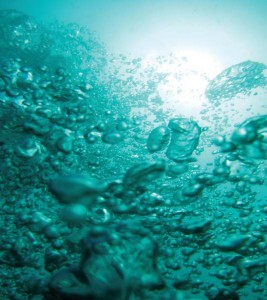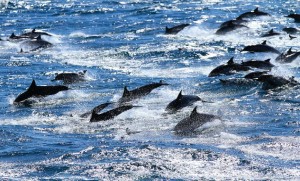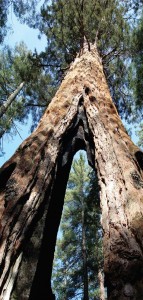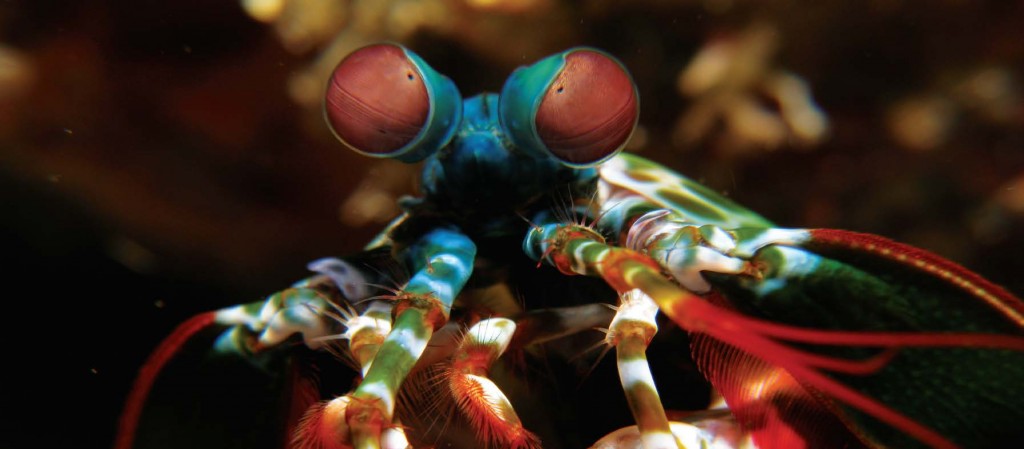MONDAY, 3 FEBRUARY 2014
How can life bring water to the boil? Humans now manage it conveniently with fire, kettles, and even laser beams. Nature, on the other hand, has struggled with the process of boiling water, and creating microscopic bubbles, for millions of years. However, when successful, the process performs several important functions for plants and animals alike. Furthermore, scientists have learnt that initiating similar reactions in patients can have important medical benefits.Like most substances, water has a boiling point that decreases with lower pressure and, at sufficiently low pressure, that boiling point can go below room temperature, right down to 0°C. The easiest way to naturally stimulate this process is by swimming. If something moves through a body of water, it generates regions of low pressure around it, as the water rushes into the space it leaves. Humans and small fish do not swim quickly enough to cause the pressure differences needed, but strong swimmers like dolphins and tuna do. At speeds of about 10 meters per second, tiny bubbles form behind their flippers.
The bubbles that form are not particularly hot, but they are generally unstable. The gas within the bubble cannot retain enough pressure to counteract the water tension and the surrounding pressure, so they collapse. For such a tiny bubble, this reaction releases huge amounts of energy, enough to superheat the surrounding region to thousands of degrees. The water has been stretched to breaking point, leaving a void or cavity inhabited only by a few water molecules–hence, the process is called cavitation. Temperatures above 5000°C are observed when the cavities implode, comparable to the surface of the sun, and little flashes of light can be seen. Dolphins appear to limit their top speed so that they do not experience this painful phenomenon, but tuna lack nerves in their bony fins and so are sometimes seen with pits and scarring from cavitation collapse. This damage is also a common sight on ship’s propellers.
What is bad for fish is good for the shrimp that want to eat them. Pistol shrimp have evolved to make one pincer fit neatly into a groove on the other. This movement forces a jet of water out, at high speed but very low pressure, causing cavitation. The sound produced can be deafening; at around 200 decibels, they compete with whales for the title of loudest creature in the ocean, and the noise regularly befuddles sonars. This event is accompanied by a flash of light and is used to communicate. It is also a deadly weapon. They get the name ‘pistol shrimp’ from using the jet to stun or even kill its prey. If you think you might want one of these cool creatures in your aquarium, be careful–the sonic blasts can crack glass. Mantis shrimp also get in on the action. While they have sharp claws, used directly to spear their prey, they also move fast enough that they can cause cavitation. This ability means they will often stun prey even if they miss.
Cavitation is not just a problem for sea creatures though–it can also happen high above sea level. Trees need to raise water tens of metres into the air to reach their tips, and to get water to rise up, you need a pressure difference between the top and bottom of the tree is needed to counteract the force of gravity. To move water higher, a higher pressure is needed, but 1 atmospheric pressure can only get water to go up about 10 metres – quite a problem for trees like the giant sequoia, which can far exceed 100 metres. An even greater pressure difference is needed if water is to actually move up the tree rather than remain stationary.
Trees draw water up to the leaves by capillary action, which is the attractive force between the water and the surrounding surface. How high the water can go in a capillary depends on how narrow the container is. In the leaves, the tubes, called xylem, branch out, narrow enough to pull the water much higher than any tree. However, the tree saves material by making its trunk out of fewer, larger xylem. These xylem are too wide to make water rise more than about a meter, so the water must be drawn up to the leaves by a strong pressure gradient. At the bottom of the tree there is typically only atmospheric pressure, so to draw water up very far the pressure must be negative in most of the trunk.
What does negative pressure mean? Basically it means that instead of the surroundings pushing on the water, they pull it along. In solids, this process would be called tension. Gases do not have strong intermolecular forces to stretch, but the bonds in liquids can be pulled–though only so far.
According to most evidence, the solution is incredible–trees keep water in a metastable state, under sufficiently negative pressure that the bonds would break if there were a defect in the xylem where a tiny void could form. Water is strongly attracted to other water molecules and to the sides of the xylem, and needs to overcome these short-range bonds to become a gas, so it usually remains liquid. However, there is always a risk of an embolism–a bubble of gas–forming in the xylem.
In droughts or frosts there is extra strain, so embolisms often occur. Air expands in the xylem and cannot sustain negative pressure, which means the xylem cannot carry water until the embolism has gone.
Some trees rely on growing new xylem after each winter, but others also try to repair old xylem by increasing the pressure at the roots above atmospheric pressure. However, the pressure achieved at the roots is not enough to get the water to the top of the tree, so there is on-going debate as to exactly how trees manage to heal embolisms. Cavitation has provided great challenges for life, and it has generally been overcome–sometimes through ways humans cannot yet grasp.
Though we may not always understand it, humans use cavitation in some medical situations. When treating kidney stones with ultrasonic blasts, some of the erosion of the kidney stones is caused by the sonic waves inflating gas bubbles until they collapse, causing powerful jets. Ultrasound treatment must work in bursts to allow this energy to dissipate, as the disruption can shield later sound waves or damage nearby tissue. Researchers have also developed a method of using microsecond laser pulses to generate two nearby bubbles, one after the other. These bubbles expand into each other and then pop. Whereas normally cavitation collapse produces shockwaves or jets in random directions, the two- bubble interaction allows a controlled, directional microjet that can be used to carve a pore of a few hundred nanometers in cell membranes without killing the cell. This process opens up the cell, so we can easily introduce new genetic material or large drugs into it, showing great potential for both detailed biological research and new therapies.
These bubbles may be tiny, but they impact on life of all sizes–from tiny shrimp to huge trees. With a little forethought, we can change their reputation as a nuisance on ship’s propellers to that of a powerful tool to investigate and improve the functioning of our own bodies.
Robin Lamboll is a 1st year PhD student in the Department of Physics





